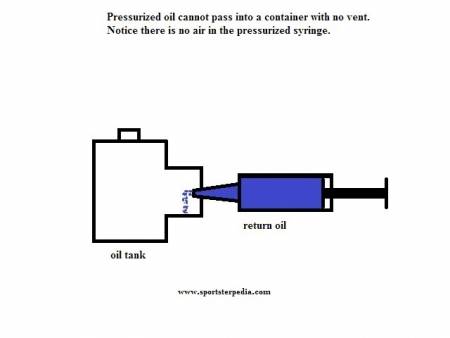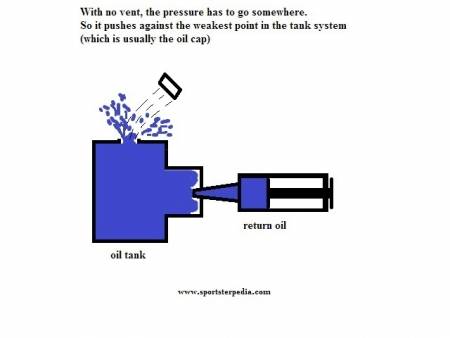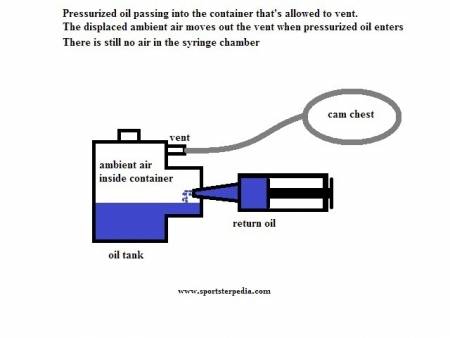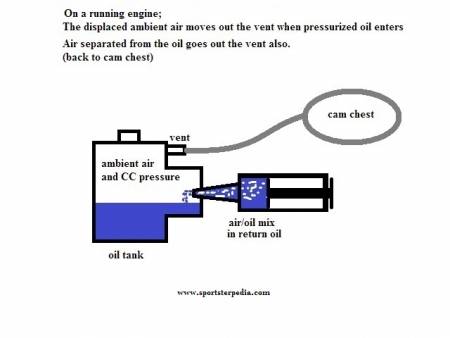Table of Contents
This is an old revision of the document!
REF: Oiling & Lubrication
Sportster Oil Pressure (57 to Present)
See also Installing an Oil Pressure Gauge in the Sportsterpedia.
All Sportsters have oil pressure, even ironheads.
It's also been said that putting an oil gauge on an ironhead is useless due to the low oil pressure they operate on.
However, most Sportsters operate off low oil pressure especially during hot idle.
The pressure source is shared between the oil pump and crankcase pressure from the action underneath the pistons.
The first answer is to rely on the oil light.
However, an oil gauge can be fitted to any Sportster.
Oil Pumps
See also in the Sportsterpedia:
Ironhead Oil Pumps
Evo Oil Pumps
- All Sportster oil pumps are unregulated during operation and will deliver their entire volume of oil under pressure to the engine or oil filter mount (respectively).
- The oil pump is geared to the pinion shaft and operates faster (increasing oil pressure) or slower (decreasing oil pressure) depending on the revs used.
- Oil viscosity will affect oil pressure.
- On a cold startup, the oil's viscosity is thicker and this will result in a higher oil pressure but circulation will be restricted somewhat.
- As the engine warms up, oil gets hot and thinner resulting in higher circulation and a decrease in oil pressure.
- Oil pressure readings are generally taken at the oil pressure switch outlet (oil pressure switch removed).
- However, the pressure figures for 86-91 models (listed in the FSMs) are based on testing from the tappet hole plug on the engine case between the tappets.
(although, a gauge can be installed at the pressure switch or the oil pump with the proper fittings)
- Installing a gauge on the rocker boxes will not do a lot of good for comparison or useable results.
- The oil source is transferred from hydraulic (oil pump) to gravity and slung force (piston down-force) by the time it gets to the rockers.
- An adapter can be added at the oil pump housing to split the piping to the oil pressure switch or filter pad (respectively)and the oil pressure gauge.
- Run the engine to normal operating temperature and check the gauge.
- Check your readings against the expected oil pump pressures below or your FSM.
Priming the Oil Pump
A dry pump won't pump oil.
It will 'cavitate' when their is not a hydraulic seal between the gerotors and the inlet hose from the tank.
Any time you have removed the oil pump or the removed / drained the feed hose from the oil tank, the pump needs to be primed.
- The oil pump needs to be primed with oil / lube before it can transfer oil from the inlet to the outlet cavity inside.
- Prime the oil pump per the FSM;
- Upon removal / inspection, oil the pump internals.
- Remove the oil pressure switch and rotate the engine until oil comes out the end of the pump and reinstall the switch.
- If you let it sit long enough, oil will gravity drain inside the pump and prime it.
- Another way to prime the pump is to use assembly lube on the gerotors and inside of the pump before installing it. 1)
Then you have an instant hydraulic seal to help the oil pump suck oil from the hose. - You can also using a large syringe with a tapered tip inserted into the oil supply hose on the bottom of the oil tank. 2)
Then you can force feed oil the pump and on to the engine using this technique and it avoids having to mess with the sending unit.
Oil Pressure Specs
Expected oil pump pressure per FSM's:
Gauge installed at the oil pump
As checked with hot oil and a gauge at the oil pressure switch location at the oil pump.
The oil pressure switch has to be removed for the gauge to be installed.
Oil filter is on the return side of the oil pump giving less restriction to the feed side.
1957-1969: 3)
Minimum: 3-7 psi (idle, with spark retarded)
Normal riding conditions: 10-14 psi (6 psi at 20 mph)
1970-1978: 4)
Minimum: 3-7 psi (idle)
Maximum: 15 psi (60 mph in high gear)
Normal riding conditions: 4-15 psi
1979-1985: 5)
Minimum: 4-7 psi (idle)
Maximum: 10-20 psi (3500 rpm)
Normal riding conditions: 4-15 psi
Gauge installed at the tappet hole plug
As checked with hot oil and a gauge at the plug hole on the engine case between the tappets.
The plug between the tappets has to be removed for the gauge to be installed.
Oil filter is on the feed side of the pump giving more restriction on the feed side.
1986-1990: 6) 7)
Minimum: 1-7 psi (idle)
Normal riding conditions: 5-30 psi (2500 rpm)
1991: 8)
Minimum: 7-12 psi (idle)
Normal riding conditions: 12-17 psi (2500 rpm)
Gauge installed at the oil filter pad
As checked with hot oil and a gauge at the oil pressure switch location at oil filter pad.
The oil pressure switch has to be removed for the gauge to be installed.
1986-1990: 9)
Oil pressure, when checked at the oil filter pad (oil pressure switch removed), will be 6-10 psi higher than when checked at the tappet plug on the case at idle.
See pressure figures above when checked at the tappet plug hole.
1992-2004: 10) 11) 12) 13) 14) 15) 16)
Minimum: 7-12 psi (idle speed varies from 950-1050 rpm between the different FSMs)
Normal riding conditions: 10-17 psi (2500 rpm)
2013 XR1200X: 17)
Minimum: 16-20 psi (idle)
Normal riding conditions: 40-44 psi (2500 rpm)
Oil pressure relief (50 psi)
- It includes an oil cooler with a thermostat that starts to open at 190ºF (88ºC).
- The oil pump and the head breathers are a new design.
The oil pump rotors are driven by the cams, the feed rotor is driven off the front intake cam and the scavenge rotor is driven by the rear exhaust cam.
Gauge installed at the rocker box
Installing a gauge at the rocker box is basically useless in diagnosing from the FSM.
There are no specs in the manuals to support any readings taken from the rockers.
However, below are some noted pressure readings from XLFORUM members.
IH engine
A 0-15 psi gauge (although it will max out with a cold motor) will give you the most accurate readings with hot oil. 18)
A 0-30 psi gauge is only useful at cold temps.
A 0-60 psi gauge is useless when testing from the rocker box.
All of this depends on the oil you are running also.
Multiple viscosity oils will show low to no pressure at running hot or cold idle.
50 wt in the summer shows lower pressure while 60 wt.
- 3-5 psi at hot idle.
- 15 psi+ when cold.
- 7-10 psi during normal riding conditions.
Other XLF member results noted from the rocker box:
- Cold start, running 20/50, - pressure off the scale at startup. 19)
- Settled to 8-9 psi after a few minutes at fast idle.
- After 2 miles, the pressure was steady at 12 psi.
- After 5 miles, pressure dropped to 1-2 psi.
- After 11 miles, pressure dropped to zero and stayed there.
- When stopped at end of ride, it stayed at zero on idle.
- Will see if the same thing happens at the weekend.
Oil Tank Pressure
There should not be any noticeable pressure in the oil tank due to the generated pressure being vented back into the cam chest. 20)
Because you can't physically pump more oil out of your motor than you pump in, the larger return pumps air also. 21)
(in addition to the return oil in order to make up the volume difference).
You will see this if you remove the cap off the oil tank and start the motor.
The return oil enters the tank in spurts with the air in between the spurts.
This in turn means more volume gets put back into the tank from the return side than gets removed from the tank by the supply side.
So the tank gets pressurized and that cant be allowed to happen.
It's the vent line's job to allow that extra air volume to exit the tank and go back to where it came from, the gearcase.
During normal operation;
With the tank cap / dipstick removed, tank pressure is vented to atmosphere from the top of the tank.
With the tank cap / dipstick installed, tank pressure is vented to the cam chest.
During shutdown;
The oil tank vent is connected to the cam chest and the cam chest is vented out the breather valve(s) in the cam cover or heads, respectively.
So if you have pressure in your oil tank and the vent to the cam chest is not blocked then the cam chest is also pressurized.
If the cam chest is holding pressure, then your breather valve(s) can not be venting properly.
Bottom line is that if the vent system is working properly, you shouldn't have excessive pressure build up in the oil tank. 22)
Conditions where oil seeps or spews from the oil tank include;
- Blocked oil tank vent line / hose.
- The vent line being blocked will keep the pressure in the tank until it builds enough to blow out the cap.
- Blocked / stopped up crankcase breather vent.
- With blocked or non-working breather(s), engine performance will also suffer.
- Too much oil in the engine, oil tank or both. 23)
- Check your FSM or owners manual for the proper amount of oil to add.
- Sportsters are known for wet sumping (condition where oil from the tank seeps into the engine while not running).
- Once the engine is started, the oil pump scavenge georotors will return the engine's sump oil back to the tank.
(in theory, at a rate faster than the feed gerotors can send oil to the engine from the tank on a warmed up engine) - There are conditions that would slow the speed at which oil returns to the tank however.
Too much standing oil in the sump added to worn oil pump internals, condition of the pressure relief valve and oil filter can slow the pump's ability to clear the sump. - Oil can drain down into the motor from the tank for a number of reasons when it has been sitting for a long time.
Then, the dipstick will give a false reading because some of that oil went into the engine. - If you already have 1-2 quarts seep down the feed line and into the engine and then add more to the oil tank,
the excess oil will either blow out the breather valve(s) or the oil tank.- Oil level should only be checked or added to with a warmed engine as per the FSM.
- If you're not sure of the collective amount of oil in the system (as in buying a used bike), drain the engine and oil tank and refill with the proper amount.
(when draining cold oil, you will not get all of the existing oil to drain out of the engine)
So, it may be better to drain and add the proper amount minus a half quart, run it up to temp and recheck, then add some more if needed. - You may not be able to see or access the sump drain plug as it may be blocked by the frame.
- 86-91 engines have a pressure relief valve set at 30-35 psi.
During a cold start, the pressure relief will dump unfiltered oil into the gearcase until the oil heats up enough (lowering oil pressure) and the relief valve closes.
Likewise, repeated start/stops before allowing the oil to heat up will dump more oil into the engine faster than the scavenge pump can return it to the oil tank.
- Oil lines not routed to the correct fittings.
- If you've removed or replaced your oil lines, double check that they are connected to the right fittings.
- Replacing the hollow head breather bolts for regular ones. 24)
- On 91-up engines, installing a regular bolt in place of the OEM hollow bolts can cause this issue.
- That would block crankcase pressure up in the engine and cause degradation of engine performance.
- If upgrading to an aftermarket A/C, you must account for an alternate method to vent crankcase pressure if you're not using the OEM hollow bolts.
- A plugged up oil filter should not cause this issue.
- All spin on oil filters have a pressure relief valve built into them.
- It is designed to still deliver (unfiltered) oil to the engine in the case of blockage of the filter media at no extra pressure increase.
- Oil tank blew up in cold weather. 25)
- 04-up models have plastic oil tanks. The belief is that some moisture gets frozen in the vent line on 04-09 tanks causing the rupture.
- It's a plastic tank so it is not going to be anything like a pressure cooker if it does happen, just messy..
- The worst of it is replacing all the parts (and not being able to ride while waiting for parts to arrive).
- The newer upgraded tanks have a better venting design to prevent this.
- In 2010, the MoCo put a 10 psi relief valve in the oil tank (presumably to prevent this sort of issue).
- The relief valve will prevent having to replace the oil tank but the jury is still out on the actual cause of the problem.
- This has happened to a handful of XLFORUM members (statistically, a pretty small number).
- But there are plenty of riders who have ridden in below freezing temperatures that haven't had a problem.
Crankcase Pressure / Venting in the Oil Tank
Air inside the tank doesn't get there because of CC pressure alone.
Ambient air resides in the upper portion of the tank above the oil level.
The air was there first. Then the oil was added. If you add too much oil, there will be even less air in the tank.
This would result in a need to move crankcase pressure out of the tank faster to keep up with incoming pressure.
A lower oil level in the tank would facilitate more area for CC pressure to collect before venting out.
Some have claimed that lowering the oil level in the tank reduces wet sumping.
There may some truth to that in the short run for reasons above.
But that is more like using a band-aid to cover a more important underlying condition of too much total crankcase pressure.
That condition doesn't just go away when you lower the oil level.
There should be a variant oil level in the tank depending on many factors.
The displacement of ambient air and CC pressure in the tank relies on the engine breather vent(s).
If the engine can't breath, the system locks up. However, it may be compounded due to air/oil separation once there.
In the drawings below, a syringe is used to example crankcase pressure being applied into the oil tank:
Since it's not the oil pump scavenger's job to separate the oil/air mist, both crankcase pressure and oil end up in the oil tank. 28)
So one function of the oil tank is to allow for air to separate out of the oil once there. 29)
The oil falls to the bottom while the air separates from the oil and goes into the tank vent back to the crankcase.
From there, the air gets circulated out the engine breather vent(s) and back into the intake to burn off hydrocarbons.
(or sometimes re-circulated into the scavenger passage)
So, in essence, the oil tank acts as an oil / air separator like the breather valve but the air only expels the engine from the engine's breather vent.
The piston movements in the HD engine are not in apposing positions to balance out the displacement of air.
They are mounted on the same crank pin and oscillate into a small volume crankcase.
Crankcase air pulses from a pressure condition to a vacuum condition inside the engine.
With the pistons movements being so close together, air is pushed and then pulled with each piston's up and down stroke.
This 'push-pull' condition affects oil scavenge from the engine to the oil tank.
Crankcase pressure and oil is both pushed towards and pulled from the scavenger passage in the sump.
Likewise, so is pressure to and from the oil tank.
As far as the oil tank is concerned, picture blowing up a balloon halfway, then letting the air out and repeating.
On one hand, you can picture both oil and CC pressure being pushed to and from the oil tank.
On the other, the oil pump scavenger creates more flow pressure than the force of CC pressure.
So one could also see that as the oil pump sends oil/air to the tank on piston down stroke and negative (vacuum) pressure pulls air back thru the vent.
See more here Evo Crankcase Pressure on engine breathing, crankcase pressure and blowby in the REF section of the Sportsterpedia.
If the oil tank vent line is plugged up, the oil pump will still send air/oil pressure into the tank.
The air pressure can't leave the tank but the oil is recirculated from the tank into the engine by the feed side of the pump.
Pressure will build in the tank until the cap blows, oil leaks from the cap or the oil tank splits (plastic).
You still have the same amount of pressure on the engine side of the plugged up vent line.
And that pressure is still being vented out the engine breather(s) as normal.
However, a plugged vent line will hinder oil pump scavenging.
This will result in less oil going to the tank and more oil gathering in the sump waiting to be scavenged.
And that can lead to wet sumping with more oil in the sump than usual.




